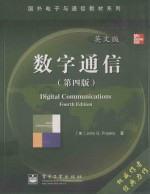图书介绍
数字通信 第4版 英文版 digital communications foruth editionPDF|Epub|txt|kindle电子书版本网盘下载

- 著
- 出版社:
- ISBN:
- 出版时间:未知
- 标注页数:0页
- 文件大小:156MB
- 文件页数:1020页
- 主题词:
PDF下载
下载说明
数字通信 第4版 英文版 digital communications foruth editionPDF格式电子书版下载
下载的文件为RAR压缩包。需要使用解压软件进行解压得到PDF格式图书。建议使用BT下载工具Free Download Manager进行下载,简称FDM(免费,没有广告,支持多平台)。本站资源全部打包为BT种子。所以需要使用专业的BT下载软件进行下载。如BitComet qBittorrent uTorrent等BT下载工具。迅雷目前由于本站不是热门资源。不推荐使用!后期资源热门了。安装了迅雷也可以迅雷进行下载!
(文件页数 要大于 标注页数,上中下等多册电子书除外)
注意:本站所有压缩包均有解压码: 点击下载压缩包解压工具
图书目录
1 Introduction1
1.1 Elements of a Digital Communication System1
1.2 Communication Channels and Their Characteristics3
1.3 Mathematical Models for Communication Channels10
1.4 A Historical Perspective in the Development of Digital Communications13
1.5 Overview of the Book15
1.6 Bibliographical Notes and References16
2 Probability and Stochastic Processes17
2.1 Probability17
2.2 Stochastic Processes61
2.3 Bibliographical Notes and References75
Problems75
3 Source Coding80
3.1 Mathematical Models for Information Sources80
3.2 A Logarithmic Measure of Information82
3.3 Coding for Discrete Sources90
3.4 Coding for Analog Sources—Optimum Quantization103
3.5 Coding Techniques for Analog Sources121
3.6 Bibliographical Notes and References140
Problems141
4 Characterization of Communication Signals and Systems148
4.1 Representation of Band-Pass Signals and Systems148
4.2 Signal Space Representations158
4.3 Representation of Digitally Modulated Signals168
4.4 Spectral Characteristics of Digitally Modulated Signals201
4.5 Bibliographical Notes and References221
Problems222
5 Optimum Receivers for the Additive White Gaussian Noise Channel231
5.1 Optimum.Receiver for Signals Corrupted by Additive White Gaussian Noise231
5.2 Performance of the Optimum Receiver for Memoryless Modulation254
5.3 Optimum Receiver for CPM Signals283
5.4 Optimum Receiver for Signals with Random Phase in AWGN Channel300
5.5 Performance Analysis for Wireline and Radio Communication Systems313
5.6 Bibliographical Notes and References318
Problems319
6 Carrier and Symbol Synchronziation333
6.1 Signal Parameter Estimation333
6.2 Carrier Phase Estimation338
6.3 Symbol Timing Estimation359
6.4 Joint Estimation of Carrier Phase and Symbol Timing366
6.5 Performance Characteristics of ML Estimators368
6.6 Bibliographical Notes and References371
Problems372
7 Channel Capacity and Coding376
7.1 Channel Models and Channel Capacity376
7.2 Random Selection of Codes392
7.3 Communication System Design Based on the Cutoff Rate402
7.4 Bibliographical Notes and References408
Problems409
8 Block and Convolutional Channel Codes416
8.1 Linear Block Codes416
8.2 Convolutional Codes471
8.3 Coded Modulation for Bandwidth-Constrained Channels—Trellis-Coded Modulation522
8.4 Bibliographical Notes and References539
Problems541
9 Signal Design for Band-Limited Channels548
9.1 Characterization of Band-Limited Channels548
9.2 Signal Design for Band-Limited Channels554
9.3 Probability of Error in Detection of PAM574
9.4 Modulation Codes for Spectrum Shaping578
9.5 Bibliographical Notes and References588
Problems588
10 Communication Through Band-Limited Linear Filter Channels598
10.1 Optimum Receiver for Channels with ISI and AWGN599
10.2 Linear Equalization616
10.3 Decision-Feedback Equalization638
10.4 Reduced Complexity ML Detectors647
10.5 Iterative Equalization and Decoding—Turbo Equalization649
10.6 Bibliographical Notes and References651
Problems652
11 Adaptive Equalization660
11.1 Adaptive Linear Equalizer660
11.2 Adaptive Decision-Feedback Equalizer677
11.3 Adaptive Equalization of Trellis-Coded Signals678
11.4 Recursive Least-Squares Algorithms for Adaptive Equalization682
11.5 Self-Recovering(Blind)Equalization693
11.6 Bibliographical Notes and References704
Problems705
12 Multichannel and Multicarrier Systems709
12.1 Multichannel Digital Communications in AWGN Channels709
12.2 Multicarrier Communications715
12.3 Bibliographical Notes and References723
Problems724
13 Spread Spectrum Signals for Digital Communications726
13.1 Model of Spread Spectrum Digital Communication System728
13.2 Direct Sequence Spread Spectrum Signals729
13.3 Frequency-Hopped Spread Spectrum Signals771
13.4 Other Types of Spread Spectrum Signals784
13.5 Synchronization of Spread Spectrum Systems786
13.6 Bibliographical Notes and References792
Problems794
14 Digital Communications through Fading Multipath Channels800
14.1 Characterization of Fading Multipath Channels801
14.2 The Effect of Signal Characteristics on the Choice of a Channel Model814
14.3 Frequency-Nonselective,Slowly Fading Channel816
14.4 Diversity Techniques for Fading Multipath Channels821
14.5 Digital Signaling over a Frequency-Selective,Slowly Fading Channel840
14.6 Coded Waveforms for Fading Channels852
14.7 Multiple-Antenna Systems878
14.8 Bibliographical Notes and References885
Problems887
15 Multiuser Communications896
15.1 Introduction to Multiple Access Techniques896
15.2 Capacity of Multiple Access Methods899
15.3 Code-Division Multiple Access905
15.4 Random Access Methods922
15.5 Bibliographical Notes and References931
Problems933
Appendix A The Levinson-Durbin Algorithm939
Appendix B Error Probability for Multichannel Binary Signals943
Appendix C Error Probabilities for Adaptive Reception of M-Phase Signals949
C.1 Mathematical Model for M-Phase Signaling Communication System949
C.2 Characteristic Function and Probability Density Function of the Phase θ952
C.3 Error Probabilities for Slowly Rayleigh Fading Channels953
C.4 Error Probabilities for Time-Invariant and Ricean Fading Channels956
Appendix D Square-Root Factorization961
References and Bibliography963
Index993